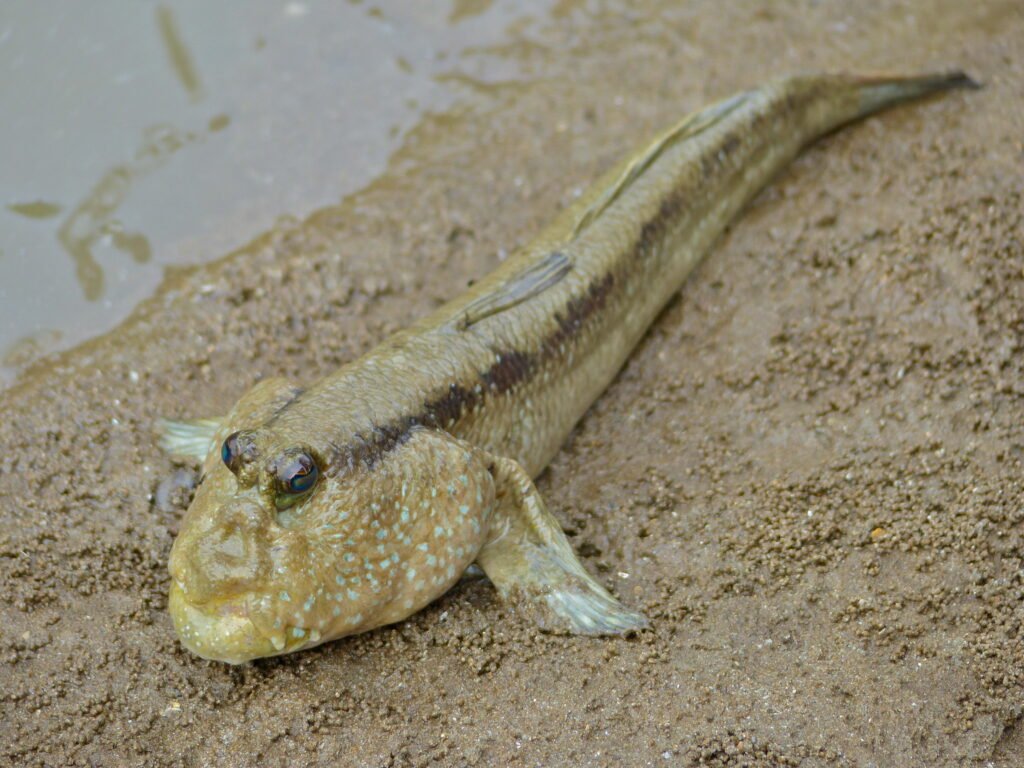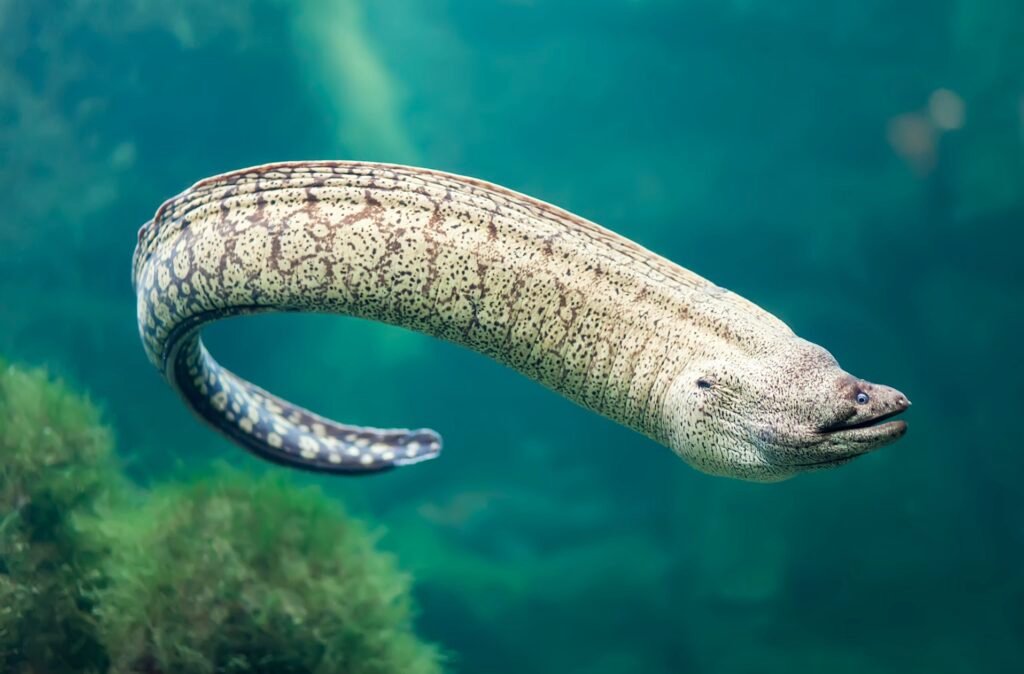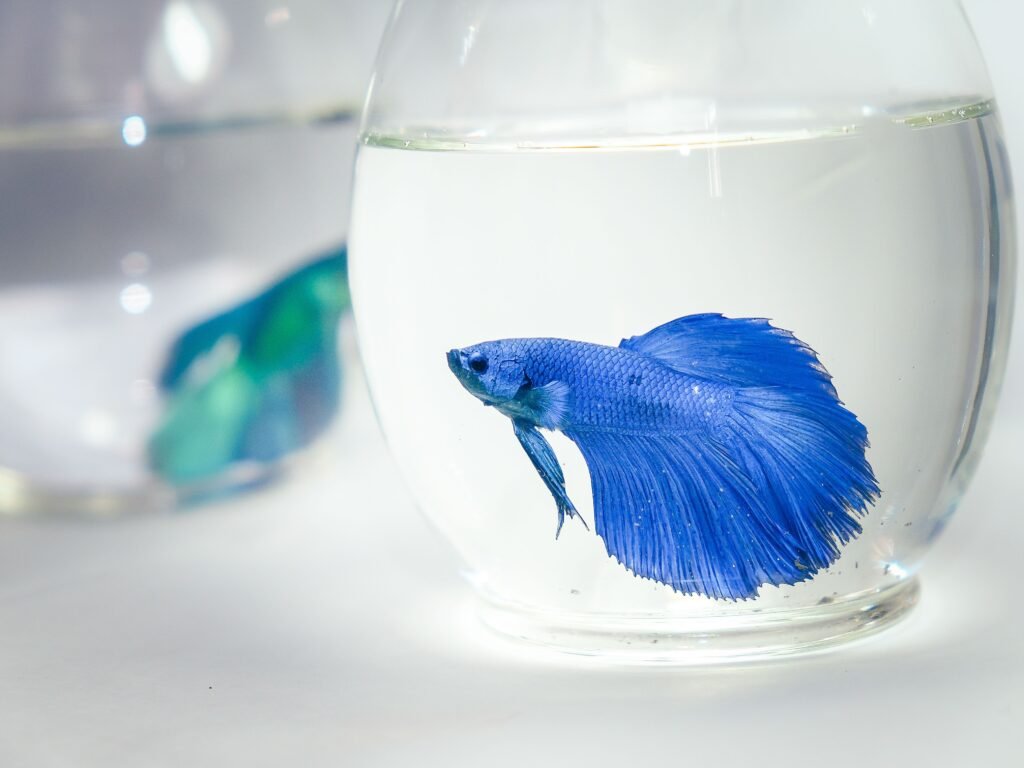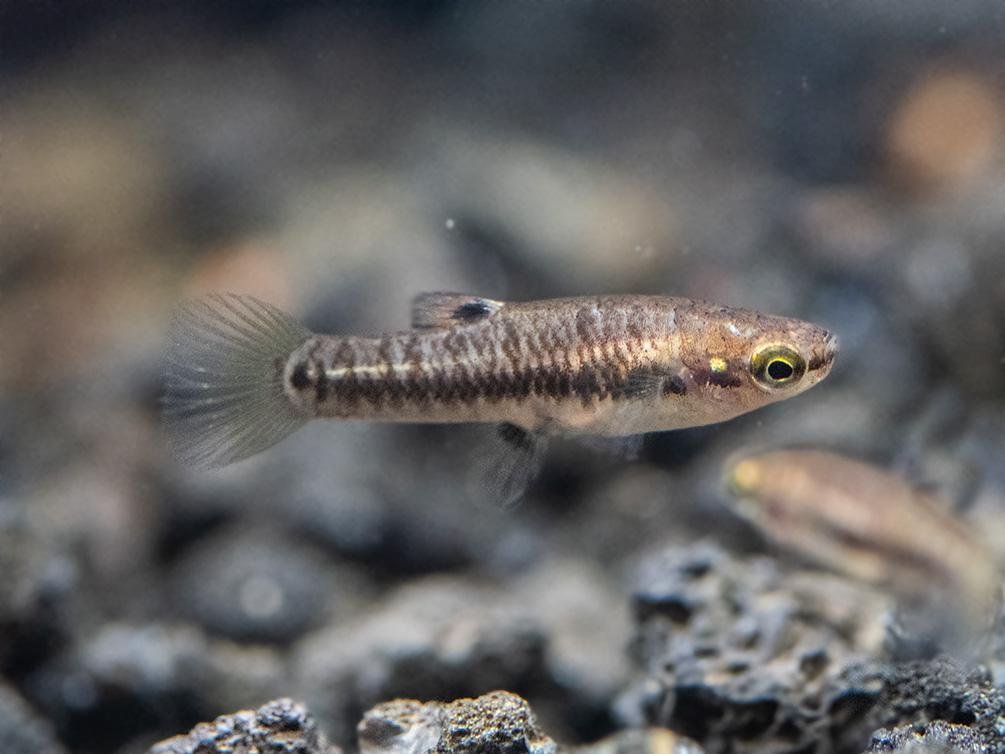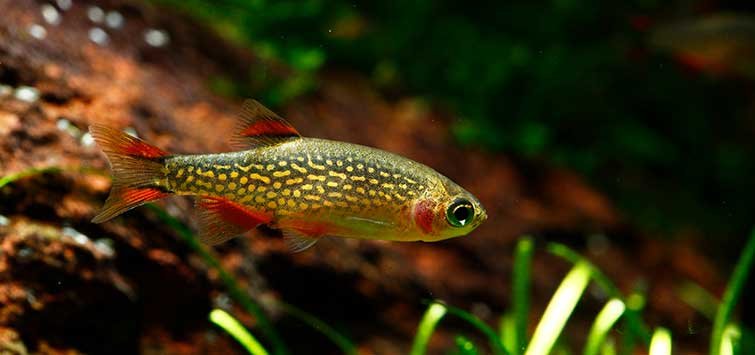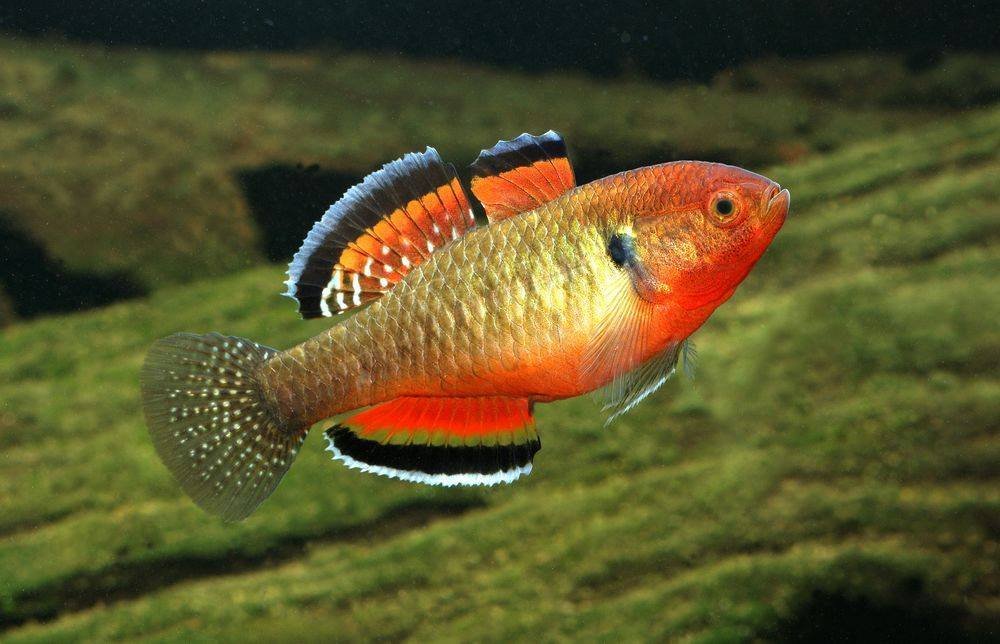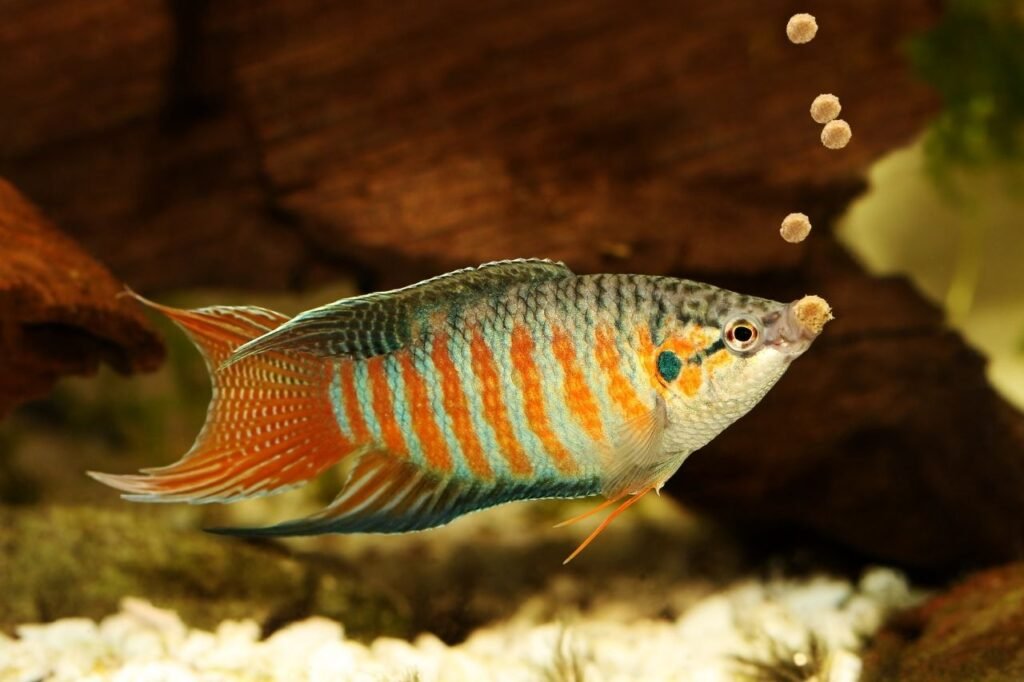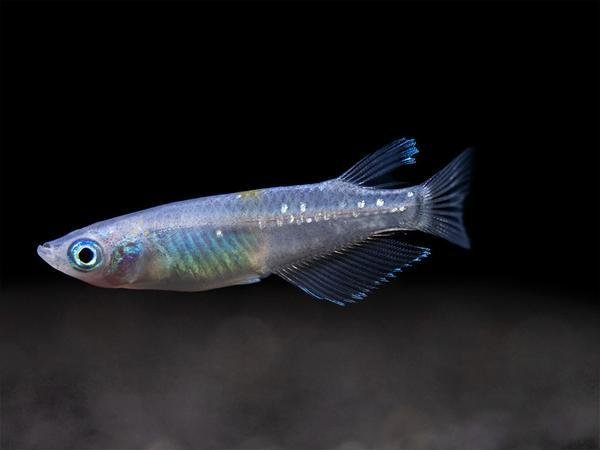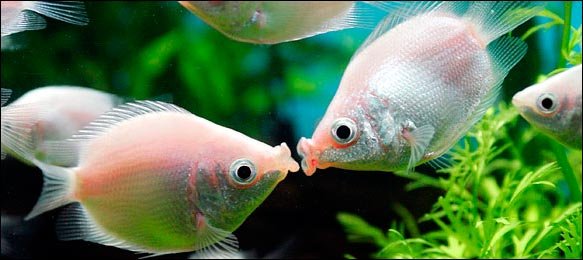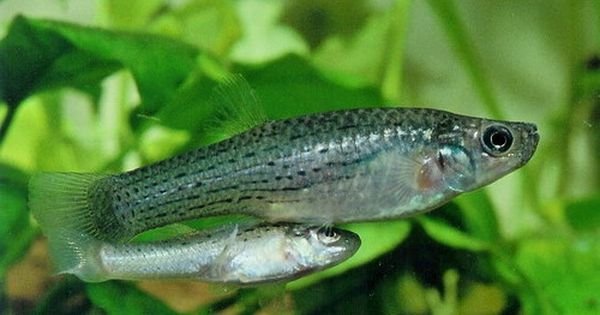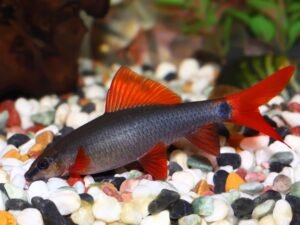In this guide, we will delve into the world of aggressive freshwater fish, exploring their special traits, tank set up, habitat, tankmates and appropriate care requirements.
We’ll also help you with being able to decrease aggressive behaviours in community tanks.
Factors That Affect Aquarium Fish Aggression
Aggressive behaviors can vary quite considerably between fish. With some fish the behavior is inherit, whilst with others aggressiveness may come about when provoked, or when the tank habitat is not appropriate for them.
Before purchasing aggressive fish, it is necessary to understand the requirements of each species that you plan to introduce to your tank.

Aggression During Breeding
Aggression in some fish is only evident during breeding times. A primal instinct kicks-in. It becomes a priority at all costs for the fish to establish a territory, fight off rivals, gain a mate and to protect young.
In many cases, juveniles are placid and get along peacefully in a community tank and with others of the same species. They only develop the aggressive behaviors on sexual maturity.
With consideration of feeding requirements, places to hide within a tank, compatible tank-mates and an appropriately sized tank, can all reduce aggressive behavior of adult fish wanting to breed.
- Add custom text here
Prices pulled from the Amazon Product Advertising API on:
Product prices and availability are accurate as of the date/time indicated and are subject to change. Any price and availability information displayed on [relevant Amazon Site(s), as applicable] at the time of purchase will apply to the purchase of this product.
Provocation Causing Aggression
Larger territorial fish, such as Arowana fish, require extra large tanks if they are to coinhabit with other fish species.
These large fish need room to swim and feel relaxed. When they are forced to be in a confined space they will be more aggressive towards fish that come close to it.
This runs true with many of the smaller aggressive freshwater fish too. Never overcrowd their tanks and provide plenty of places for them to establish their territories and for them to hide if necessary. If they feel stressed they may chase and nip other fish.
Tankmates that are domineering will also cause fish with aggressive tendencies to feel threatened. This provocation can become a problem with anxious fish lashing out in self-preservation. Understanding which tankmates coexist best with your aggressive species will reduce aggression.
Some species like to be in a school as this gives them a sense of security having friends around them. Species such as Tiger Barbs are less aggressive towards one another and towards other fish in the tank if kept in groups of five or more.
In addition, when only two or three are kept together, the dominant fish may be inclined to bully the lesser fish.
Aggressive Freshwater Fish Are Usually Carnivorous
Carnivorous species of freshwater fish will eat pretty much any fish, invertebrate or mollusc that can fit in its mouth. By nature, many are ambush fish, keeping hidden, then darting out to eat prey. Piranhas will do this in groups, making them an even bigger threat in a tank with other smaller fish.
Slow moving fish, and fish with long fins, are an easy target. It is better to keep fish in the tank who can keep out of the way of carnivorous fish. Ensure plenty of hiding spots as well as room for these fish to keep their distances.
Feeding Time Leads to Aggressive Freshwater Fish
When food is presented to fish, often their true colors show. Larger aggressive fish dominate and will scoff the food before other fish get their share.
In many cases, these bossy fish are generally peaceful in the tank. It is simply the excitement at feeding time that provokes aggressiveness. Large adult plecos are an example of a fish that can become bossy at feeding time.
To reduce the aggressive behavior of fish during feeding time it better to spread the food around the tank, allowing some to float and some to sink. This way the fish spread out and all have an opportunity to eat.
12 Popular Aggressive Freshwater Fish
Tiger Barbs

When kept alone, Tiger Barbs can terrorize and potentially kill smaller fish. They tend to nip at fins and bully more passive species, such as guppies, goldfish, and betta fish. This behavior becomes more intense when Tiger Barbs are kept in smaller groups.
Prices pulled from the Amazon Product Advertising API on:
Product prices and availability are accurate as of the date/time indicated and are subject to change. Any price and availability information displayed on [relevant Amazon Site(s), as applicable] at the time of purchase will apply to the purchase of this product.
Tiger Barbs thrive in water temperatures between 77-86°F. They will show less aggressive behavior when kept at optimal water temperature.
These fish do better when kept in groups of five or more. Individuals kept on their own are vulnerable and may feel threatened, which can lead to them being aggressive towards tank-mates. Also, in a group the pecking order has been established and the bullies amongst them can’t target single fish as they may if there were only a couple of barbs in the tank.
To reduce aggressive behavior in Tiger Barbs try the following:
- Provide able swimming space with plenty of places for fish to move and to also hide.
- Don’t place in a community tank with long finned passive fish.
- Keep a group of 5 or more barbs.
- Monitor their behavior and remove the aggressive individuals.
- Keep optimal water conditions.
Gourami fishes

Male gourami fish, can become confrontational and exhibit fin-nipping behavior when threatened or defending their territory. They are often aggressive towards smaller fish.
Prices pulled from the Amazon Product Advertising API on:
Product prices and availability are accurate as of the date/time indicated and are subject to change. Any price and availability information displayed on [relevant Amazon Site(s), as applicable] at the time of purchase will apply to the purchase of this product.
Originating from Southeast Asia, gouramis are adaptable to slow-moving streams and can survive in stagnant water. They prefer a water temperature of 77°F and pH 6.7.
A tank with plenty of aquarium plants will help reduce stress on the fish. Anxious gouramis can become aggressive.
Among Gourami species, Dwarf Gourami, Honey Gourami, Sparkling Gourami, and Chocolate Gouramis are generally more peaceful.
Here are some tips to reduce aggressive behavior in Gouramis:
- Keep males as individuals. Females can be kept in groups.
- Consider using a tank divider to keep gouramis away from other fish.
- Add ornaments or plants to provide additional hiding places.
- Reduce stress and anxiety by giving gouramis space, ensure water conditions are optimal, and don’t house them with other aggressive species that may threaten them.
- Keep the smaller species of gouramis in a community aquarium.
Cichlids
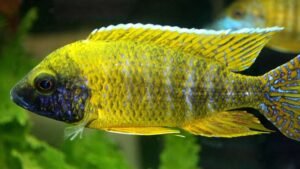
There are numerous species of cichlids from different regions of the world. Many are known for their hostility, territorial behavior, and predatory nature towards other fish and invertebrates.
There are peaceful species of cichlids that do well in community tanks, however, some of these peaceful fish become fearlessly aggressive when they want to breed.
African cichlids in particular are known for their aggression, driven by their instinct to defend there territory during breeding.
Many cichlids are predators and will hunt down smaller fish. Others can be aggressive at feeding time as they compete for their meal.
Common aggressive cichlids kept by fish enthusiasts include:
Jewel Cichlid: with its stunning breeding colors of red with flecked green-blue flanks and gill covers.
Convict Cichlid: a territorial fish that feeds on worms, insects, and algae with black stripes.
Wolf Cichlid: built with a heavy body and strong jaw for hunting prey. This fish looks menacing and should only be kept with other large cichlids.
Umbee Cichlid: A huge fish, growing to 2 feet long. Not suitable to be kept with other species as it is a real hostile fish.
Poor Man’s Tropheus: an aggressive vegetarian that eats algae from rocks and will take on fish larger than itself.![]()
Green Texus Cichlid: a hybrid cichlid that will eat any fish that can fit it its mouth.
Bumblebee Cichlid: brightly colored yellow and black aggressive species, particularly the males.
Red Devil Cichlid: a destructive fish with plenty of personality that will attack its own kind.
Acai Cichlid: a smaller species with abundant energy to defend territory and provoke other fish.
Jaguar Cichlid: A large fish that gets its name from its cat like demeanour and coloration.
Jack Demsey: named after a 1920’s boxer for its ferociousness and looks.
We delve deeper with these aggressive cichlids in another article.
- Live fish for your aquarium or fish tank.
- We will safely pack and ship your fish via Fedex priority overnight. Live arrival is guarante
Prices pulled from the Amazon Product Advertising API on:
Product prices and availability are accurate as of the date/time indicated and are subject to change. Any price and availability information displayed on [relevant Amazon Site(s), as applicable] at the time of purchase will apply to the purchase of this product.
Puffer

Pufferfish are known for their powerful bites and volatile temperaments, making them a threat to peaceful community fish in close proximity.
They have a tendency to nip fins and can display outright aggression or predatory behavior. Due to their tendency to eat other fish and invertebrates, it is not recommended to house pufferfish with them.
Pufferfish can be found in warm and temperate regions worldwide. They have thick, often spiky skin and fused teeth, featuring a beak-like structure with a central split in each jaw.
While some pufferfish can grow up to 93 cm (2 feet) in length, many species are relatively small. It’s important to note that numerous pufferfish species are toxic, containing a highly poisonous substance called tetraodontoxin, which is concentrated in their organs.
Despite the risks associated with consuming pufferfish, they are still utilized as food in certain cultures.
Among freshwater aquariums, the Amazon Pufferfish is considered one of the more docile pufferfish species.
Pea Puffer
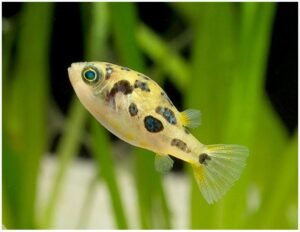
The Pea Puffer (Carinotetraodon travancoricus), also named the Dwarf Mini Puffer Fish, is one of the tiniest fish on Earth. They may appear cute, but their aggression, particularly among males, should not be underestimated.
Despite their miniature size, they will attempt to bite other fish in a community tank. It is recommended that they are best kept alone in a small aquarium. You can keep up to six pea puffers in a 20 gallon tank with plenty of shelter without other tankmates.
If putting them with tankmates, select species that can evade the nipping. Kuhli loaches, danios, neon tetras and cherry shrimp all make suitable tankmates. Ensure there is plenty of places for fish to move as well as hiding places for fish to retreat to.
Hobbyists enjoy this oddball species of fish as it has an unusual swimming manner, like a hovering helicopter. They are courageous and intelligent.
African leaf fish

The African Leaf Fish, also known as the Leopard Bush Fish, is not aggressive but highly predatory, consuming anything that can fit into its mouth. Despite its small size (3-4 inches), it can quickly eliminate all of the smaller fish in the tank.
This species originate from central Africa inhabiting pools, swamps, creeks and slow-moving rivers. They like to sit in amongst vegetation along the river banks.
The African Leaf Fish is a peaceful tank member which will get along very well with other fish species, so long as these fish are not small enough to eat. They shouldn’t he housed with other aggressive freshwater fish as they will easily be bullied.
Ideal tankmates are peaceful fish that are large enough not to be eaten, such as bala sharks, red-tail barbs, and silver dollars.
Smaller fish such as neon tetras will likely become prey if kept with this species.
Arowana

Arowanas are fiercely aggressive and do not tolerate other arowanas. The Australian arowana is considered to be the most aggressive, often killing all other fish in its tank. Silver and black arowanas are comparatively less aggressive.
In the wild, arowanas prey on fish, frogs, insects, and even larger animals like snakes and rabbits.
They have sleek bodies, reflective scales, and come in various colors and fin types. They move gracefully on the water’s surface.
Some color variations, such as the Silver arowana are valuable, with a price tag up to $25,000! Arowanas are a good luck in certain Asian cultures. They are believed to take on the illnesses of their owners.
Due to their value and aggression, most fish keepers house arowanas alone in large tanks and avoid community tanks. Due to their skittish nature Arowanas require at least 60 gallons to freely move about and a suitable lid as they will jump.
Black Wolffish

The Black Wolffish is a highly aggressive predator native to South America. It is a true predator and is a real threat to smaller fish. The aggression of this fish becomes even more so as it matures.
Usually, this fish keeps to itself. However, during times of breeding it will bond with a mate. The Wolf fish can grow to 28 inches, therefor requiring a large tank with relatively low water flow.
Suitable tankmates for this species include bichirs, silver dollars, catfish, peacock bass cichlids, and other large, fast-moving fish. Ensure there is plenty of room in the tank and plenty of hiding places.
When looking at the Wolffish you notice it’s large teeth and giant mouths. It is a true ambush predator, swiftly darting out from cover to consume its prey.
Betta Fish/Siamese Fighting Fish

Prices pulled from the Amazon Product Advertising API on:
Product prices and availability are accurate as of the date/time indicated and are subject to change. Any price and availability information displayed on [relevant Amazon Site(s), as applicable] at the time of purchase will apply to the purchase of this product.
Betta fish, also known as Siamese Fighting Fish, display aggression through flaring their gills and fins, charging, and biting.
Wild bettas are carnivorous and largely feed on insects and their larvae. Male bettas are known for their fighting behavior. They will fight with other males, damaging their fins when bitten.
Females are less aggressive and can be kept in groups so long as there is shelter for them to escape to if need be.
Bettas are highly popular due to their beauty, intelligent character, and ability to thrive in small spaces.
These small territorial fish will defend their territory from other bettas. Long-finned bettas are generally slow and not a great threat to fast-moving fish, but they may nip the tails of other long-finned fish like guppies and goldfish.
Providing plenty of space in the aquarium will prevent bettas from feeling threatened and this will reduce their aggression. Betta fish can coexist with other fish species in tanks.
It is important to avoid housing betta fish with semi-aggressive fish like Tiger Barbs, as these species are known to nip the long fins of bettas.
Plecostomus

Prices pulled from the Amazon Product Advertising API on:
Product prices and availability are accurate as of the date/time indicated and are subject to change. Any price and availability information displayed on [relevant Amazon Site(s), as applicable] at the time of purchase will apply to the purchase of this product.
This can be during times of competition for food, breeding, and battles over territory.
Juvenile fish are not a problem in a community tank. However, plecos grow quickly. One challenge with plecos is their potential growth to a large size, ranging from 12 to 24 inches, which can exceed the capacity of the aquarium.
Meeting their nutritional needs will help prevent plecos from potentially annoying other fish. When a large pleco aggressively feeds, it can intimidate other fish in the tank.
To ensure there is no competition over food, feed plecos plenty of algae wafers. Spread these around the tank.
Plecos will find places to hide out in the tank. Provide plenty of driftwood, hollows and caves large enough for them to fit inside.
Oscar

Oscars (Astronotus ocellatus) are very attractive aquarium fish with many new color ranges. They interact with their owners and will even take food from the hand.
- Live fish for aquarium or fish tank.
Prices pulled from the Amazon Product Advertising API on:
Product prices and availability are accurate as of the date/time indicated and are subject to change. Any price and availability information displayed on [relevant Amazon Site(s), as applicable] at the time of purchase will apply to the purchase of this product.
However, they do have a reputation for being fierce, dominant, and hostile fish. Oscars are aggressive towards other fish and tank decor.
This species grows up to one foot in size and requires a minimum of 55 gallons of water for one individual fish.
Oscars are destructive in the tank, showing aggression towards décor and equipment such as heaters and filters in the tank. It is best to use aquarium sumps where the aquarium equipment can be kept away from Oscars.
They do engage in “jaw” or “lip” locking when battling each other. Oscars will also nip at other fish and even human hands.
Oscars do best in an aquarium with other oscars as opposed to other fish species. If keeping them with other fish species, ensure they have similar tank requirements and have a temperament and size to match the oscars. For example, they should not be housed with African Cichlids due to their different needs.
Oscars love to eat and will produce quite a bit of tank wastes. Water changes and a large aquarium filter are necessary to keep these fish healthy.
Keep oscars in at least a pair or more if you have the room. Having three oscar fish isn’t ideal as one may be picked on if the other two pair off.
Rainbow shark

The Rainbow shark is a hardy active and easy to keep aquarium fish that is very poular amongst enthusiasts. Despite its name, this fish from tropical Thailand is not a real shark.
Rainbow sharks are not considered to be as aggressive as some of the species described above. Their semi-aggressive nature is generally only with adult fish towards other fish that inhabit the bottom of the tank.
It is best to select tankmates that can defend themselves but have a peaceful nature, such as Barbs and Danios. Rainbow sharks may display increased aggression towards other fish with a similar body type, like Rainbowfish.
Rainbow sharks are solitary. In a community aquarium it is better to keep only one shark. Provide ample space for the shark to minimize conflicts in the aquarium with other fish.
Rainbow sharks are easy to keep and with the right conditions will grow to 6 inches and live for 4-6 years. There is also an albino version of the Rainbow Shark sold in aquarium stores.
Piranha

There are over 60 species of Piranhas in the wild. They are carnivorous fish found in South American rivers and lakes, having a reputation for having razor-toothed jaws.
Piranhas are popular with aquarium hobbyists who keep them for their curiosity and aggressive nature. These fish grow to 12 inches and are best kept in groups.
Prices pulled from the Amazon Product Advertising API on:
Product prices and availability are accurate as of the date/time indicated and are subject to change. Any price and availability information displayed on [relevant Amazon Site(s), as applicable] at the time of purchase will apply to the purchase of this product.
Piranhas are attracted to the scent of blood. They are primarily scavengers, but can also hunt in groups, ambushing and chasing down their prey.
Juvenile piranhas tend to gather in groups for protection against predators. As they mature, they can become cannibalistic, attacking their own kind.
Keep piranhas with fish of similar size and temperament to avoid aggression. Piranhas can be skittish if startled and may hide in the tank.
Within a school of piranhas, a clear hierarchy forms, with the largest and most aggressive adult fish being dominant.
Ideally, house them in a 200 gallon tank where they have plenty of room to move. Small aquariums result in small unhappy fish.
Aggressive Freshwater Fish
Aggressive Freshwater Fish During Breeding
Often it is only during times of breeding that fish with an aggressive nature show their aggressiveness. Certain species become highly aggressive and protective, isolating themselves to defend their partner, nest, and fry. This behavior is very common in cichlids and snakehead species.
By understanding their behaviors and meeting their specific care requirements, aggression can be managed effectively, allowing for a captivating and harmonious aquatic environment.
- Live fish for aquarium or fish tank
Prices pulled from the Amazon Product Advertising API on:
Product prices and availability are accurate as of the date/time indicated and are subject to change. Any price and availability information displayed on [relevant Amazon Site(s), as applicable] at the time of purchase will apply to the purchase of this product.
After successful pairing, breeding fish generally reduce their territory and gather around their eggs or fry to protect them from other predatory fish in the aquarium.
Several of the African cichlids will brood their eggs and fry in their mouths, adding to the alure of these fish.
Feeding Aggressive Freshwater Fish
Aggressive freshwater fish are known for their fast swimming and voracious appetite. They may eat other fish, even stealing food from the mouths and gills of their tank mates.
To minimize competition during feeding, offer a diverse range of floating or sinking food and distribute it throughout the tank using filter outflow or powerheads.
Head Butting or Biting Behavior
Fish aggressively attacks another by head-butting or biting its head. This aggressive encounter can cause timid fish to hide for extended periods. With some species, like oscars battling fish will lock jaws with one-another.
Final Thoughts – Aggressive Freshwater Fish
The world of freshwater aquarium fish offers a diverse range of aggressive species that captivate with their colors and unique behaviors. From the dominant Red Devil Cichlid to the predatory instincts of the Piranha, these fish bring interest and beauty to the aquarium.
By carefully considering tank setup, fish habitat and nature, aquarists can create thriving environments that showcase the captivating nature of these aggressive freshwater fish.
It is a privilege to be able to witness the remarkable diversity of nature within the confines of your own home aquarium.
To discover more about aggressive freshwater fish check out our article on the 12 Top Aggressive Cichlids.
..












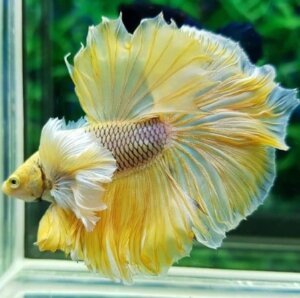

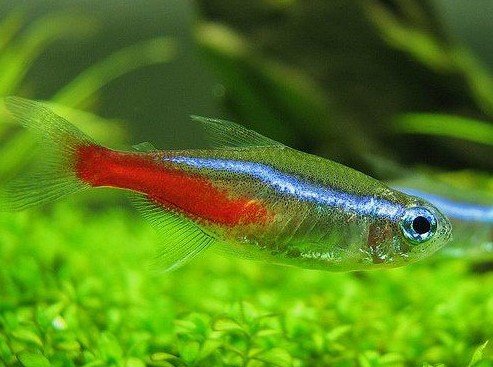

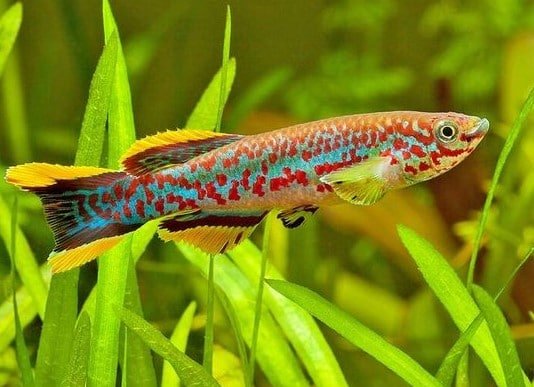
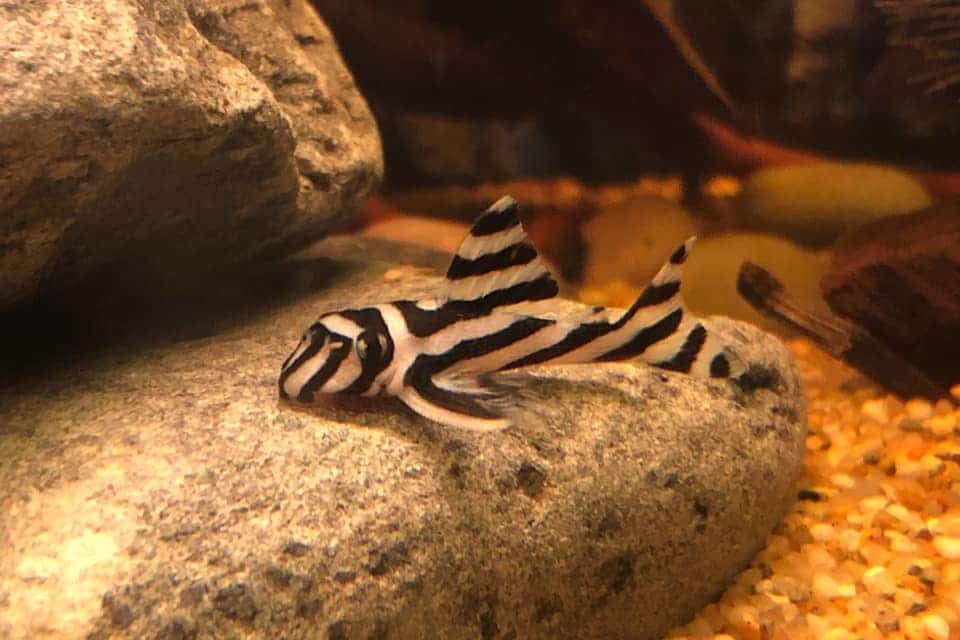
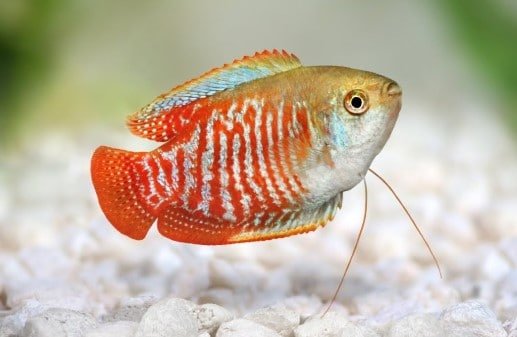
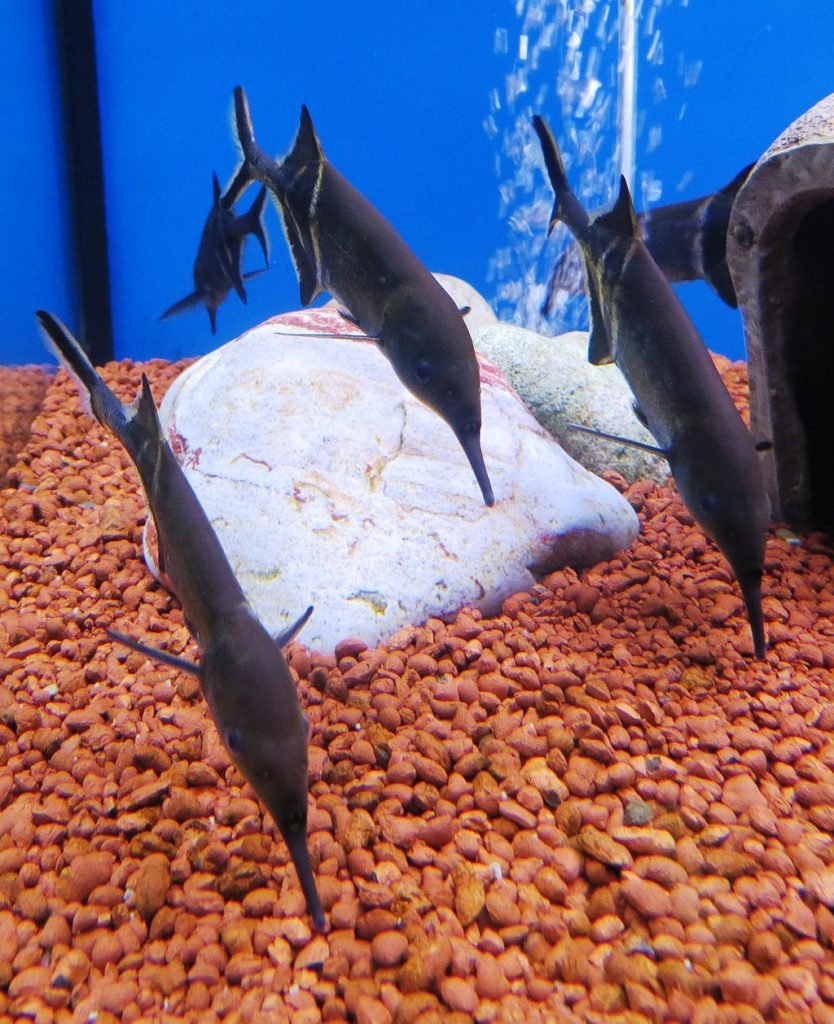


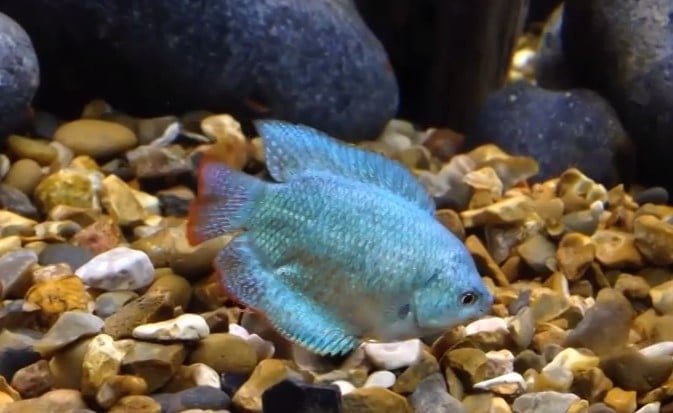

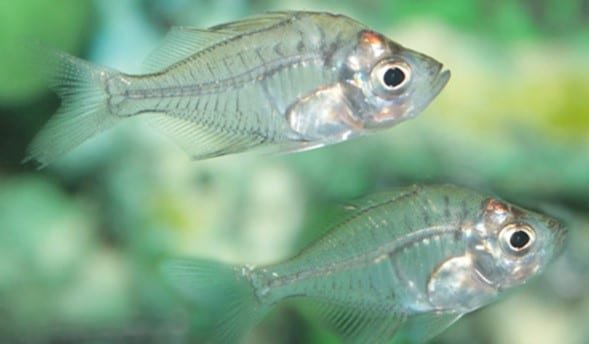
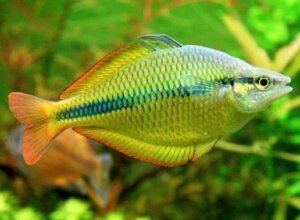
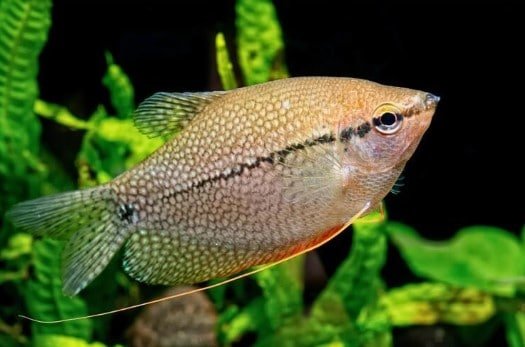
![[2023] The Ultimate Guide to Black Moor Goldfish Care Black Moor Goldfish](https://aquariumhunter.com/wp-content/uploads/2021/09/Black_Moor_Goldfish.jpg)

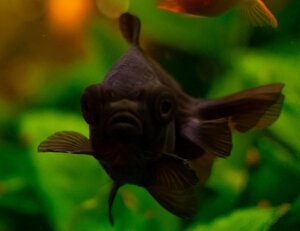




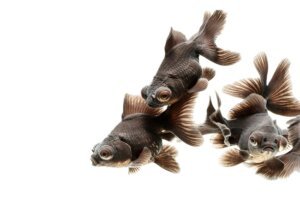








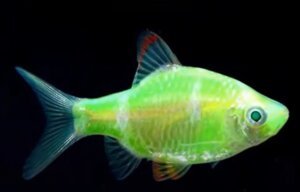

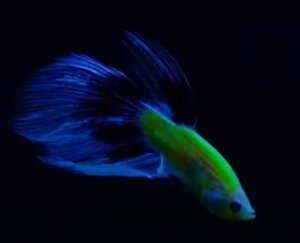
![[Updated 2023] Molly Fish Fry Care Guide – (Main Things to Do) Molly Fish Fry](https://aquariumhunter.com/wp-content/uploads/2022/01/2.jpg)
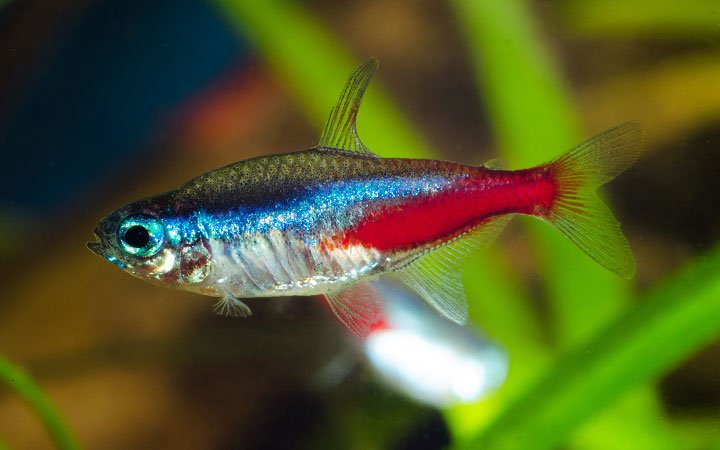



![[Complete Guide] Kuhli Loach Care: Habitat, Diet, Mates, Breeding Kuhli Loach](https://aquariumhunter.com/wp-content/uploads/2021/11/The-Ultimate-Kuhli-Loach-Care-Guid-Tank-Mates-Breeding-and-More...-Banner.jpg)










![[Surprising Facts] How long can a fish live out of water? How long can a fish live out of water](https://aquariumhunter.com/wp-content/uploads/2021/11/how-long-can-a-fish-live-out-of-water-1.jpg)
